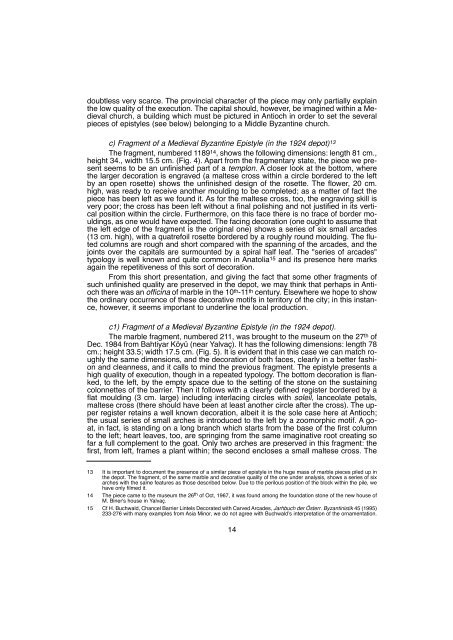--KAPAK ARAÞTIRMA kopya - Kültür ve Turizm Bakanlığı
--KAPAK ARAÞTIRMA kopya - Kültür ve Turizm Bakanlığı
--KAPAK ARAÞTIRMA kopya - Kültür ve Turizm Bakanlığı
Create successful ePaper yourself
Turn your PDF publications into a flip-book with our unique Google optimized e-Paper software.
doubtless <strong>ve</strong>ry scarce. The provincial character of the piece may only partially explain<br />
the low quality of the execution. The capital should, howe<strong>ve</strong>r, be imagined within a Medieval<br />
church, a building which must be pictured in Antioch in order to set the se<strong>ve</strong>ral<br />
pieces of epistyles (see below) belonging to a Middle Byzantine church.<br />
c) Fragment of a Medieval Byzantine Epistyle (in the 1924 depot) 13<br />
The fragment, numbered 1189 14, shows the following dimensions: length 81 cm.,<br />
height 34., width 15.5 cm. (Fig. 4). Apart from the fragmentary state, the piece we present<br />
seems to be an unfinished part of a templon. A closer look at the bottom, where<br />
the larger decoration is engra<strong>ve</strong>d (a maltese cross within a circle bordered to the left<br />
by an open rosette) shows the unfinished design of the rosette. The flower, 20 cm.<br />
high, was ready to recei<strong>ve</strong> another moulding to be completed; as a matter of fact the<br />
piece has been left as we found it. As for the maltese cross, too, the engraving skill is<br />
<strong>ve</strong>ry poor; the cross has been left without a final polishing and not justified in its <strong>ve</strong>rtical<br />
position within the circle. Furthermore, on this face there is no trace of border mouldings,<br />
as one would ha<strong>ve</strong> expected. The facing decoration (one ought to assume that<br />
the left edge of the fragment is the original one) shows a series of six small arcades<br />
(13 cm. high), with a quatrefoil rosette bordered by a roughly round moulding. The fluted<br />
columns are rough and short compared with the spanning of the arcades, and the<br />
joints o<strong>ve</strong>r the capitals are surmounted by a spiral half leaf. The "series of arcades"<br />
typology is well known and quite common in Anatolia 15 and its presence here marks<br />
again the repetiti<strong>ve</strong>ness of this sort of decoration.<br />
From this short presentation, and giving the fact that some other fragments of<br />
such unfinished quality are preser<strong>ve</strong>d in the depot, we may think that perhaps in Antioch<br />
there was an officina of marble in the 10 th-11 th century. Elsewhere we hope to show<br />
the ordinary occurrence of these decorati<strong>ve</strong> motifs in territory of the city; in this instance,<br />
howe<strong>ve</strong>r, it seems important to underline the local production.<br />
c1) Fragment of a Medieval Byzantine Epistyle (in the 1924 depot).<br />
The marble fragment, numbered 211, was brought to the museum on the 27 th of<br />
Dec. 1984 from Bahtiyar Köyü (near Yalvaç). It has the following dimensions: length 78<br />
cm.; height 33.5; width 17.5 cm. (Fig. 5). It is evident that in this case we can match roughly<br />
the same dimensions, and the decoration of both faces, clearly in a better fashion<br />
and cleanness, and it calls to mind the previous fragment. The epistyle presents a<br />
high quality of execution, though in a repeated typology. The bottom decoration is flanked,<br />
to the left, by the empty space due to the setting of the stone on the sustaining<br />
colonnettes of the barrier. Then it follows with a clearly defined register bordered by a<br />
flat moulding (3 cm. large) including interlacing circles with soleil, lanceolate petals,<br />
maltese cross (there should ha<strong>ve</strong> been at least another circle after the cross). The upper<br />
register retains a well known decoration, albeit it is the sole case here at Antioch;<br />
the usual series of small arches is introduced to the left by a zoomorphic motif. A goat,<br />
in fact, is standing on a long branch which starts from the base of the first column<br />
to the left; heart lea<strong>ve</strong>s, too, are springing from the same imaginati<strong>ve</strong> root creating so<br />
far a full complement to the goat. Only two arches are preser<strong>ve</strong>d in this fragment: the<br />
first, from left, frames a plant within; the second encloses a small maltese cross. The<br />
13 It is important to document the presence of a similar piece of epistyle in the huge mass of marble pieces piled up in<br />
the depot. The fragment, of the same marble and decorati<strong>ve</strong> quality of the one under analysis, shows a series of six<br />
arches with the same features as those described below. Due to the perilous position of the block within the pile, we<br />
ha<strong>ve</strong> only filmed it.<br />
14 The piece came to the museum the 26 th of Oct, 1967, it was found among the foundation stone of the new house of<br />
M. Biner's house in Yalvaç.<br />
15 Cf H. Buchwald, Chancel Barrier Lintels Decorated with Car<strong>ve</strong>d Arcades, Jarhbuch der Österr. Byzantinistik 45 (1995)<br />
233-276 with many examples from Asia Minor, we do not agree with Buchwald’s interpretation of the ornamentation.<br />
14

















